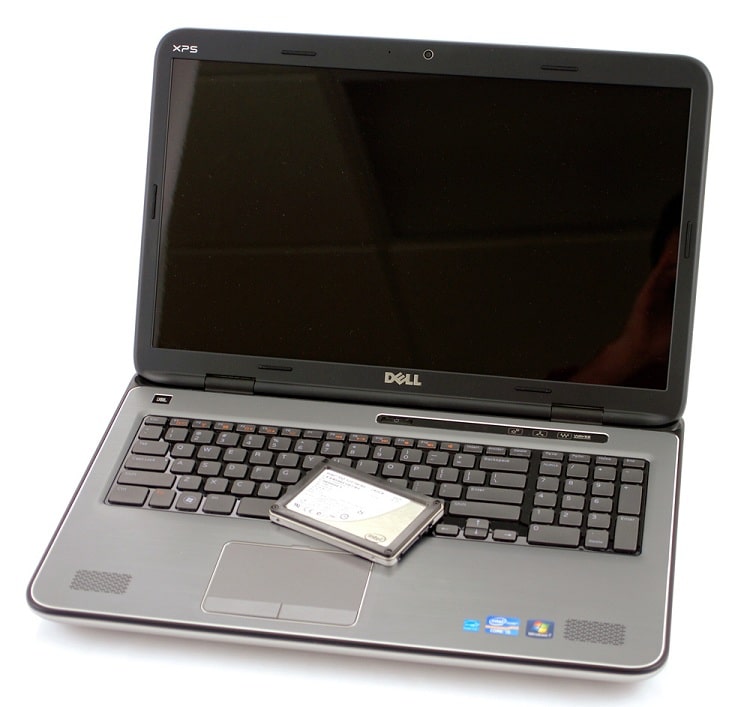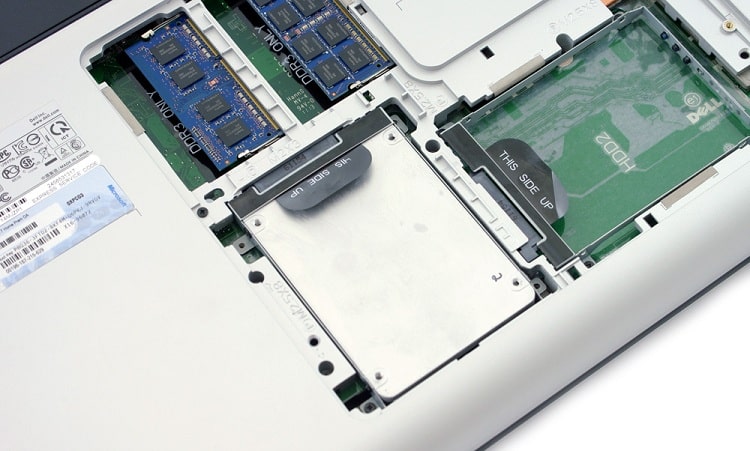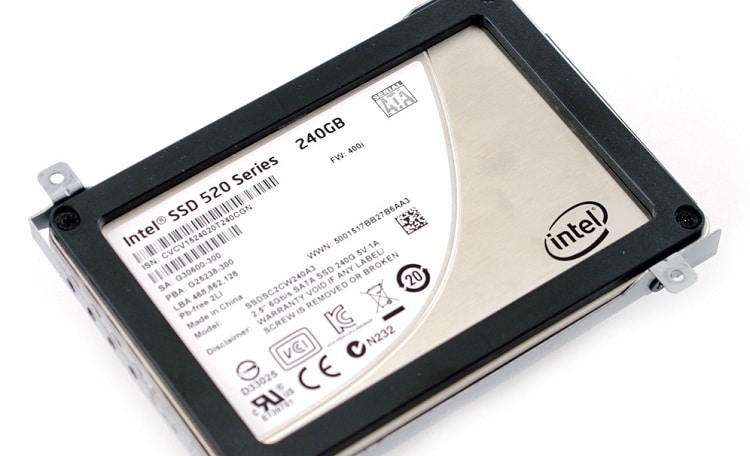The Dell XPS 17 L702X is a desktop replacement style notebook that is powered by an Intel Core i5 or i7 processor and Nvidia dedicated graphics. The XPS 17 L702X can be purchased and configured on Dell.com where it has a starting price of $899 for the entry level configuration. You are able to configure the XPS 17 to your hearts delight, but as is often the case upgrades you make at purchase time are more expensive than if you do it yourself after market. In addition to that you have no control over what brand or model of upgrade components Dell uses. For this reason we advocate doing whatever upgrades you can after market to save money and have more control.
The XPS 17 is a particularly well suited notebook for after market upgrades as it’s got dual hard drive bays and open memory slots that are easily accessible on the bottom of the machine. If you want the latest and greatest SSD technology such as the new Intel SSD 520 inside the XPS 17 instead of some mystery $370 upgrade SSD then the way to go is selecting the default HD option and then adding an SSD in the open bay or replacing the existing HD yourself after purchase.
In this guide we will go over the installation of an Intel 520 SSD into a Dell XPS 17 Laptop Reviews recently reviewed. We will then compare the original HD configuration benchmarks with those of the Intel SSD 520 equipped configuration to get an idea for the overall system performance boost you can expect.

Dell XPS 17 Test System Specs
The pertinent specs of the pre-upgrade XPS 17 system are as follows:
- Model: Dell XPS 17 (L702X)
- Processor: 2nd generation Intel Core i5-2410M processor 2.30 GHz with Turbo Boost 2.0 up to 2.90 GHz
- Storage: 640GB 7200 RPM SATA Hard Drive + 1 empty bay
- Chipset: Intel HM67
- SATA Support: SATA III (up to 6GB/s transfer) for two internal HD bays, SATA II (3GB/s) for optical drive and eSATA port
- Memory: 6GB,DDR3,2 DIMM
- Screen: 17.3 in HD+ WLED TL (1600×900) with 2.0MP HD webcam
- Graphics: NVIDIA GeForce GT 550M 1GB graphics with Optimus
- OS: Genuine Windows 7 Home Premium 64 bit, Dell OEM
- Optical Drive: 8X Tray Load CD/DVD Burner (Dual Layer DVD+/-R Drive)
The stock XPS 17 configuration here isn’t exactly mind blowing, it has a middle of the road Intel Core i5 processor and mid level Nvidia GT 550M graphics card. The 6GB of RAM and 7200RPM hard drive are fairly standard amounts and speed for a 2012 notebook. The price of this XPS 17 was a mere $699 during a sale event at Dell.com. Upgrading the processor and other components was very expensive and our theory was that installation of the fast SSD 520 after market would give a better performance boost for everyday tasks than a $400 upgrade to an Intel Core i7 processor. A note we should mention on the XPS 17, despite having dual drives we found the XPS 17 L702X does not support RAID at the hardware level, so if you had hopes of trying RAID 0 to improve performance you’re out of luck.

Installing the Intel 520 and Windows 7 Ultimate
The installation of the Intel SSD 520 into the Dell XPS 17 is pretty straight forward thanks to easy access to an extra drive bay on the bottom of the laptop. Simply remove the panel and there’s instant access to the two memory slots and two drive bays. One bay is of course occupied by whichever storage you chose at the time of configuration, the other should be empty and ready to put in a drive such as the SSD 520. We went ahead and put a clean install of Windows 7 Ultimate on the Intel SSD 520 which side stepped any Dell bloatware and as such gave an extra performance boost.
Dell XPS 17 L702X Performance Benchmarks with Intel SSD 520
One of the more popular system performance benchmarking tools for the PC is the PCMark suite from FutureMark. PCMark measures overall system performance based on a battery of tests that stress each component of a PC. To get an idea of the overall system performance improvement for the XPS 17 with the stock HD versus with the Intel 520 we ran both the latest PCMark 7 benchmark and the previous version PCMark Vantage. The results speak for themselves:
| Dell XPS 17 with Stock 7200RPM HD | Dell XPS 17 with Intel SSD 520 and Clean Windows 7 Install | Score Improvement % with Intel SSD 520 |
|
| PCMark Vantage Overall Score | 6,329 | 13,162 | 108% |
| PCMark Vantage Storage Score | 3,405 | 54,289 | 1,494% |
| PCMark 7 Overall Score | 2,077 | 3,507 | 68% |
| PCMark 7 Storage Score | 1,589 | 5,342 | 236% |
Now, before you take even the more conservative 68% performance improvement as being the bible truth for what the Intel 520 will do for your PC compared to an HD, remember this is just an artificial number. It should be taken to mean that your system will undoubtedly be more responsive and noticeably snappier with applications and bootup. However, not every usage situation will benefit. For instance, 3D gaming that relies heavily on a good dedicated graphics card might not run 68% faster and jump from 30 FPS to 50 FPS simply by having the Intel SSD 520. The SSD can certainly help speed up loading a program along with its image data and scenes, but beyond that it’s really the graphics card that will determine the performance of games on a PC. That caveat aside, let’s call these results what they are, amazing! It’s clear that installing a fast SSD such as the Intel SSD 520 is where it’s at in terms of getting a better performing PC. Processor upgrades are expensive, and generally only eek out a couple of percentage points of system speed for every extra $100 you spend. SSD upgrades are similarly expensive, but the jump in performance for things that matter, such as boot up time and application loading, is going to give an incredible boost to the real and perceived performance you get as a user.
Conclusion
We’ve been trained to focus on the processor as the most important component affecting overall system performance, but the truth is that a fast SSD is really where it’s at for improving overall system performance and speed these days. Even the middle of the road Intel Core i5 processor should provide ample performance for most users today, paying $300 to upgrade to a Core i7 will only net you a few percentage points of speed advantage. Instead, you should put any upgrade money allowance toward the purchase of a current generation SSD such as the Intel 520.

The system performance improvement will absolutely be more noticeable and actually meaningful, not just something you need a benchmark to measure. Intel will gladly sell you faster processors and continue to innovate there, but assuming your budget is finite and you want to know where to spend your dollars to get the best return on performance, buy a new SSD from Intel instead of processor.
Related Articles
About The Author: Andrew Baxter is the Editor of LaptopReviews.com where he writes news and reviews covering the laptop industry. He is also a Contributing Editor at StorageReview.com.




 Amazon
Amazon